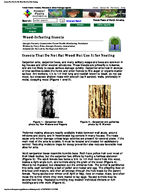Insects That Do Not Eat Wood But Use It for Nesting Forest Pests: Insects, Diseases & Other Damage Agents
Home About Us Partners Help
Search: enter search
go
q Insects
q Forest Pest Images
q Diseases
Advanced Search
q Weeds
Wood-Infesting Insects
Georgia Forestry Commission Forest Health Monitoring Factsheets Written by Terry Price, Georgia Forestry Commission Adapted for the web by the Bugwood Network
Forest Pests of North America q Other Agents
Insects That Do Not Eat Wood But Use It for Nesting
Carpenter ants, carpenter bees, and many solitary wasps and bees are common in log houses and other wooden structures. These insects are primarily a nuisance, and are not likely to cause serious damage quickly. Carpenter ants nest in stumps or tree cavities outside the home and enter homes to find sugar or organic matter as food. Ant workers, 1/4 to 1/2 inch long and reddish brown to black, do not eat wood, but excavate shallow nests with smooth (as if sanded) walls, preferably in moist, decaying wood (Figure 1 and 2).
Figure 1 - Carpenter Ants photo by Van Waters and Rogers
Figure 2 - Carpenter ant galleries photo by R. Werner
Preferred nesting sites are readily available inside between wall studs, around windows and doors, and in heartwood log centers in many houses. The nests cause only minor damage unless large colonies are present for several years. If the main nest of the ants is outside, it must be located and treated for satisfactory control. Reducing moisture traps for decay prevention also reduces favorable nest sites for ants.
Adult carpenter bees resemble bumble bees. Both have yellow hair over most of their black bodies, but the carpenter bee differs by having a hairless abdomen (Figure 3). The adult female bee bores a 3/8- to 1/2-inch round hole into wood, makes a right angle turn, and tunnels along the grain of the wood (Figure 4). Wood is not ingested, but discarded out the entrance hole. The tunnel is partitioned into cells, each containing a ball of pollen and nectar and egg. The offspring feed on this food until mature, and then all emerge through the hole made by the parent female. Young adults over winter until April or May, feed on nectar, mate, and often reuse the tunnel where they were reared to lay eggs. Reused tunnels may be several feet long. Repeated tunneling may weaken individual timbers or ruin moldings and trim work (Figure 5).
http://www.forestpests.org/gfcfacts/woodinfesting.html (1 of 2)8/25/2006 2:13:57 PM
Insects That Do Not Eat Wood But Use It for Nesting
Figure 3 - Carpenter bee photo by Terry Price
Figure 4 photo from USDA Forest Service - Wood Products Insect
Lab Archives
Solitary wasps and bees place food and eggs in beetle exit holes in log walls and seal the hole with a "wall" of dirt (Figure 6). The offspring bores a small hole in the wall of dirt to come out, often causing powdered dirt to accumulate beneath the hole. This is sometimes mistaken for a beetle infestation. These insects do not harm wood; caulking beetle holes to prevent decay eliminates them.
Injecting recommended insecticides into nests and tunnels will control carpenter bees. Dust formulations often work best. Don't seal treated bee holes until the bees are allowed to move freely over the insecticide. The holes can be plugged in the fall with a wooden dowel or silicon sealer. Preventing nesting by bees in logs is very difficult, even pressure-treated wood is sometimes attacked. Painting frequently attacked timber will sometimes discourage bees. Substituting pine facia boards with white oak worked for one homeowner in eliminating carpenter bee boring.
Figure 5 - Carpenter bees readily attack brick and eaves molding
photo by Bill Godfrey
Figure 6 photo by Bill Godfrey
[ Contents ] [ Home ]
Forest Pests.org is a part of the Bugwood Network The University of Georgia - Warnell School of Forest Resources and College of Agricultural & Environmental Sciences - Dept. of Entomology
In cooperation with the Georgia Forestry Commission. Funding and Support provided by the USDA Forest Service
Home | Accessibility Policy | Privacy Policy | Disclaimers | Contact Us
Last updated on Wednesday, March 23, 2005 at 11:08 AM www.forestpests.org version 2.0, XHTML 1.1, CSS, 508.
http://www.forestpests.org/gfcfacts/woodinfesting.html (2 of 2)8/25/2006 2:13:57 PM
